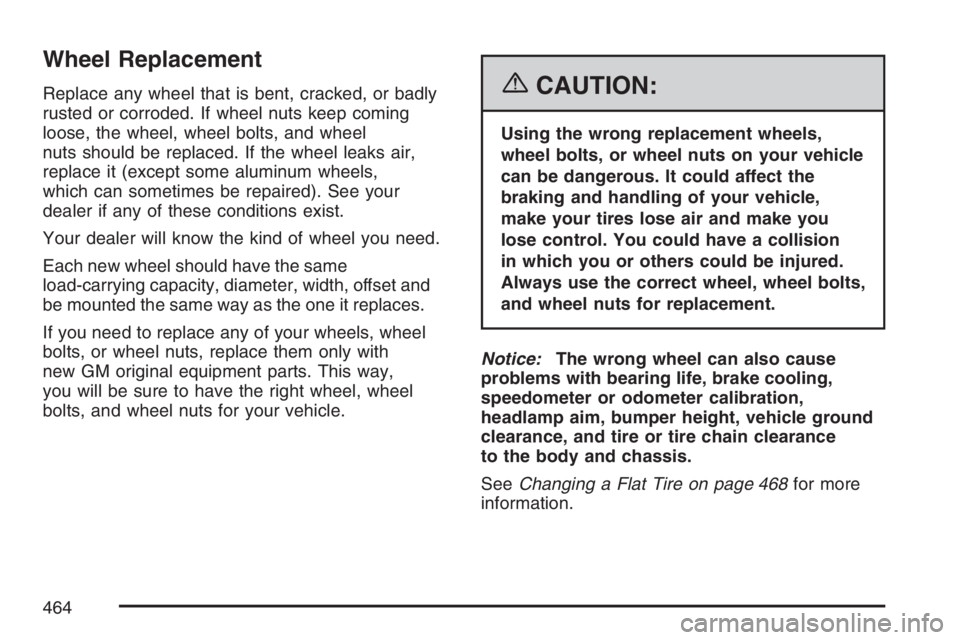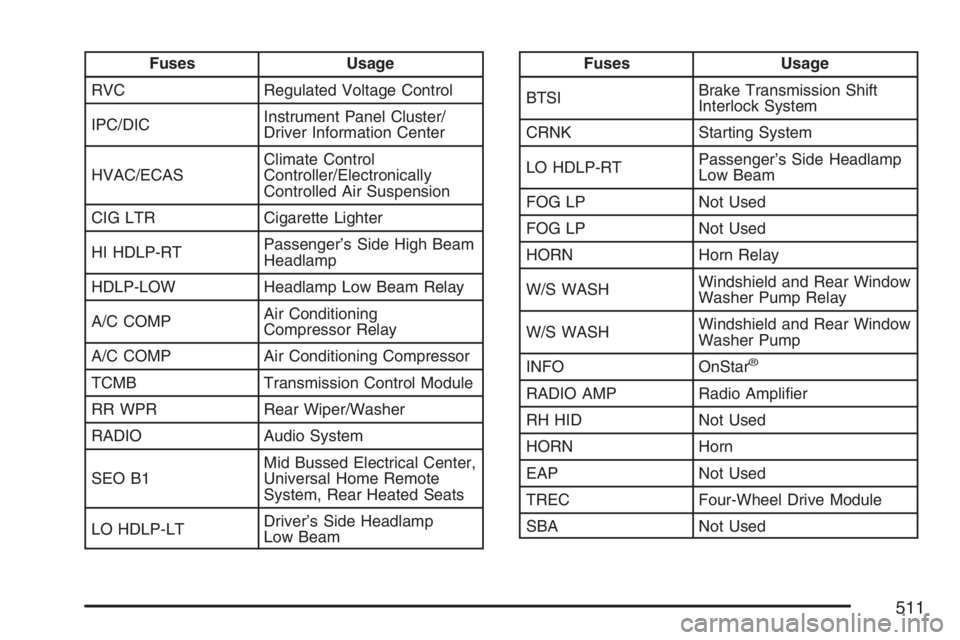headlamp HUMMER H2 2007 Owner's Manual
[x] Cancel search | Manufacturer: HUMMER, Model Year: 2007, Model line: H2, Model: HUMMER H2 2007Pages: 570, PDF Size: 3.34 MB
Page 342 of 570

To install a step:
1. Before installing the bolts:
Remove all traces of the original adhesive
patch.
Clean the threads of the bolts with
denatured alcohol or equivalent and allow
threads to dry.
Apply Threadlocker (GM Part No. 12345382,
in Canada 10953489) or equivalent.
2. Install the side step to the vehicle. You may
need someone to assist you in the installation.
3. Install the nuts and bolts for the two
inner brackets �rst, but do not tighten them.
4. Using a level, make sure the step is level in
relationship to the vehicle. Then, tighten the
inner bracket nuts and bolts.
5. Install the other nuts and bolts. Tighten all
nuts and bolts to 39 lb ft (50
Y).
Driving at Night
Night driving is more dangerous than day driving.
One reason is that some drivers are likely to
be impaired — by alcohol or drugs, with night
vision problems, or by fatigue.
Here are some tips on night driving.
Drive defensively.
Do not drink and drive.
Adjust the inside rearview mirror to reduce the
glare from headlamps behind you.
Since you cannot see as well, you may need
to slow down and keep more space between
you and other vehicles.
Slow down, especially on higher speed roads.
Your vehicle’s headlamps can light up only so
much road ahead.
In remote areas, watch for animals.
If you are tired, pull off the road in a safe
place and rest.
342
Page 343 of 570

No one can see as well at night as in the daytime.
But as we get older these differences increase.
A 50-year-old driver may require at least twice as
much light to see the same thing at night as a
20-year-old.
What you do in the daytime can also affect your
night vision. For example, if you spend the
day in bright sunshine you are wise to wear
sunglasses. Your eyes will have less trouble
adjusting to night. But if you are driving, do not
wear sunglasses at night. They may cut down on
glare from headlamps, but they also make a
lot of things invisible.
You can be temporarily blinded by approaching
headlamps. It can take a second or two, or
even several seconds, for your eyes to re-adjust
to the dark. When you are faced with severe glare,
as from a driver who does not lower the high
beams, or a vehicle with misaimed headlamps,
slow down a little. Avoid staring directly into
the approaching headlamps.Keep the windshield and all the glass on your
vehicle clean — inside and out. Glare at night is
made much worse by dirt on the glass. Even the
inside of the glass can build up a �lm caused
by dust. Dirty glass makes lights dazzle and �ash
more than clean glass would, making the pupils
of your eyes contract repeatedly.
Remember that the headlamps light up far less
of a roadway when you are in a turn or curve.
Keep your eyes moving; that way, it is easier
to pick out dimly lighted objects. Just as the
headlamps should be checked regularly for proper
aim, so should your eyes be examined regularly.
Some drivers suffer from night blindness — the
inability to see in dim light — and are not even
aware of it.
343
Page 357 of 570

You will need a well-charged battery to restart the
vehicle, and possibly for signaling later on with your
headlamps. Let the heater run for a while.
Then, shut the engine off and close the window
almost all the way to preserve the heat. Start
the engine again and repeat this only when you
feel really uncomfortable from the cold. But do it as
little as possible. Preserve the fuel as long as
you can. To help keep warm, you can get out of
the vehicle and do some fairly vigorous exercises
every half hour or so until help comes.
If Your Vehicle is Stuck in Sand,
Mud, Ice, or Snow
In order to free your vehicle when it is stuck,
you will need to spin the wheels, but you do not
want to spin your wheels too fast. The method
known as rocking can help you get out when you
are stuck, but you must use caution.
{CAUTION:
If you let your vehicle’s tires spin at high
speed, they can explode, and you or others
could be injured. And, the transmission or
other parts of the vehicle can overheat.
That could cause an engine compartment
�re or other damage. When you are stuck,
spin the wheels as little as possible. Do not
spin the wheels above 35 mph (55 km/h) as
shown on the speedometer.
Notice:Spinning the wheels can destroy parts
of your vehicle as well as the tires. If you
spin the wheels too fast while shifting
the transmission back and forth, you can
destroy the transmission.
For information about using tire chains on your
vehicle, seeTire Chains on page 465.
357
Page 389 of 570

Service........................................................ 392
Accessories and Modi�cations................... 392
California Proposition 65 Warning.............. 393
Doing Your Own Service Work.................. 393
Adding Equipment to the Outside of
Your Vehicle.......................................... 394
Fuel............................................................. 394
Gasoline Octane........................................ 394
Gasoline Speci�cations.............................. 394
California Fuel........................................... 395
Additives................................................... 395
Fuels in Foreign Countries........................ 396
Filling the Tank......................................... 397
Filling a Portable Fuel Container............... 399
Checking Things Under the Hood.............. 400
Hood Release........................................... 400
Engine Compartment Overview.................. 402
Engine Oil................................................. 404
Engine Oil Life System.............................. 407
Engine Air Cleaner/Filter............................ 409
Automatic Transmission Fluid.................... 412
Engine Coolant.......................................... 415Coolant Surge Tank Pressure Cap............ 418
Engine Overheating................................... 418
Overheated Engine Protection
Operating Mode..................................... 420
Cooling System......................................... 420
Power Steering Fluid ................................. 425
Windshield Washer Fluid........................... 426
Brakes...................................................... 427
Battery...................................................... 431
Jump Starting............................................ 432
Rear Axle.................................................... 437
Four-Wheel Drive........................................ 438
Front Axle................................................... 440
Bulb Replacement....................................... 441
Halogen Bulbs........................................... 441
Headlamps................................................ 441
Front Turn Signal and Parking Lamps.......... 442
Daytime Running Lamps (DRL)................. 443
Roof Marker Lamps................................... 443
Taillamps, Turn Signal, Stoplamps and
Back-up Lamps...................................... 444
Replacement Bulbs................................... 446
Section 5 Service and Appearance Care
389
Page 441 of 570

Bulb Replacement
For the proper type of replacement bulbs, see
Replacement Bulbs on page 446.
For any bulb changing procedure not listed in this
section, contact your dealer.
Halogen Bulbs
{CAUTION:
Halogen bulbs have pressurized gas
inside and can burst if you drop or
scratch the bulb. You or others could be
injured. Be sure to read and follow the
instructions on the bulb package.
Headlamps
To replace a headlamp bulb, do the following:
1. Open the hood. SeeHood Release on
page 400for more information.
2. Locate the affected headlamp on the inner
front portion of the hood.
3. Turn the bulb/
socket retainer
counterclockwise
to unlock the
bulb/socket.
You may prefer to unplug the electrical
connector before removing the bulb/socket.
If so, complete Step 5 before doing this step.
4. Pull the bulb/socket straight out from
the headlamp housing.
441
Page 442 of 570

5. Unplug the electrical
connector.
6. Push the new bulb socket into the headlamp
assembly making sure to align the splines
on the bulb socket with the splines in the
headlamp housing. Use care not to touch the
bulb with your �ngers or hands.
7. Turn the bulb socket retainer clockwise to lock
it into place.
8. Plug in the electrical connector.Front Turn Signal and Parking Lamps
To replace a front turn signal or parking lamp bulb,
do the following:
1. Open the hood. SeeHood Release on
page 400for more information.
2. Locate the bulb you need to change.
3. Turn the bulb socket
counterclockwise
and remove it
from the lamp
housing.
4. Pull the bulb from the bulb socket.
5. Install the new bulb into the bulb socket.
6. Reinstall the bulb socket into the lamp housing
and turn it clockwise until it locks.
442
Page 446 of 570

Your vehicle may have a taillamp in the bumper.
To replace it, do the following:
1. Locate the affected
taillamp which is
behind and
under the bumper.
2. Turn the bulb socket counterclockwise and
remove it from the lamp housing.
3. Remove the bulb from the bulb socket.
4. Install the new bulb into the bulb socket.
5. Reinstall the bulb socket into the lamp housing
and turn it clockwise to lock it.Replacement Bulbs
Exterior Lamp Bulb Number
Back-up Lamp 3156K
Daytime Running Lamp (DRL) 4114K LCP
Front Turn Signal and
Parking Lamp4157K or 3157KX
Low-Beam and High-Beam
Headlamps9007
Rear Taillamp and Stoplamp 3057K
Rear Taillamp in Bumper 3057K
Rear Turn Signal Lamp 3156K
Roof Marker Lamp Center 168
Roof Marker Lamp Corner 194
For replacement bulbs not listed here, contact
your dealer.
446
Page 464 of 570

Wheel Replacement
Replace any wheel that is bent, cracked, or badly
rusted or corroded. If wheel nuts keep coming
loose, the wheel, wheel bolts, and wheel
nuts should be replaced. If the wheel leaks air,
replace it (except some aluminum wheels,
which can sometimes be repaired). See your
dealer if any of these conditions exist.
Your dealer will know the kind of wheel you need.
Each new wheel should have the same
load-carrying capacity, diameter, width, offset and
be mounted the same way as the one it replaces.
If you need to replace any of your wheels, wheel
bolts, or wheel nuts, replace them only with
new GM original equipment parts. This way,
you will be sure to have the right wheel, wheel
bolts, and wheel nuts for your vehicle.{CAUTION:
Using the wrong replacement wheels,
wheel bolts, or wheel nuts on your vehicle
can be dangerous. It could affect the
braking and handling of your vehicle,
make your tires lose air and make you
lose control. You could have a collision
in which you or others could be injured.
Always use the correct wheel, wheel bolts,
and wheel nuts for replacement.
Notice:The wrong wheel can also cause
problems with bearing life, brake cooling,
speedometer or odometer calibration,
headlamp aim, bumper height, vehicle ground
clearance, and tire or tire chain clearance
to the body and chassis.
SeeChanging a Flat Tire on page 468for more
information.
464
Page 510 of 570

Fuses Usage
PARK LP Parking Lamps Relay
STRTR Starter Relay
INTPARK Roof Marker Lamps
STOP LP Stoplamps
TBC BATTTruck Body Controller
Battery Feed
SEO B2 Off-Road Lamps
4WS Not Used
AUX PWRInstrument Panel Outlets,
Rear Cargo Area Power
Outlets, Console
PCM 1 Powertrain Control Module
ETC/ECMElectronic Throttle Control,
Electronic Brake Controller
IGN EInstrument Panel Cluster,
Air Conditioning Relay, Turn
Signal/Hazard Switch, Starter
Relay, Electronic Brake
Controller TC2 Mode Switch
RTDElectronic Brake Controller
Battery FeedFuses Usage
TRL B/U Backup Lamps Trailer Wiring
F/PMP Fuel Pump (Relay)
B/U LPBack-up Lamps, Automatic
Transmission Shift Lock
Control System
RR DEFOG Rear Window Defogger
HDLP-HI Headlamp High Beam Relay
PRIME Not Used
AIRBAGSupplemental In�atable
Restraint System
FRT PARKFront Parking Lamps,
Sidemarker Lamps
DRLDaytime Running Lamps
(Relay)
SEO IGN Rear Defog Relay
TBC IGN1 Truck Body Controller Ignition
HI HDLP-LTDriver’s Side High Beam
Headlamp
LH HID Not Used
DRL Daytime Running Lamps
510
Page 511 of 570

Fuses Usage
RVC Regulated Voltage Control
IPC/DICInstrument Panel Cluster/
Driver Information Center
HVAC/ECASClimate Control
Controller/Electronically
Controlled Air Suspension
CIG LTR Cigarette Lighter
HI HDLP-RTPassenger’s Side High Beam
Headlamp
HDLP-LOW Headlamp Low Beam Relay
A/C COMPAir Conditioning
Compressor Relay
A/C COMP Air Conditioning Compressor
TCMB Transmission Control Module
RR WPR Rear Wiper/Washer
RADIO Audio System
SEO B1Mid Bussed Electrical Center,
Universal Home Remote
System, Rear Heated Seats
LO HDLP-LTDriver’s Side Headlamp
Low BeamFuses Usage
BTSIBrake Transmission Shift
Interlock System
CRNK Starting System
LO HDLP-RTPassenger’s Side Headlamp
Low Beam
FOG LP Not Used
FOG LP Not Used
HORN Horn Relay
W/S WASHWindshield and Rear Window
Washer Pump Relay
W/S WASHWindshield and Rear Window
Washer Pump
INFO OnStar
®
RADIO AMP Radio Ampli�er
RH HID Not Used
HORN Horn
EAP Not Used
TREC Four-Wheel Drive Module
SBA Not Used
511